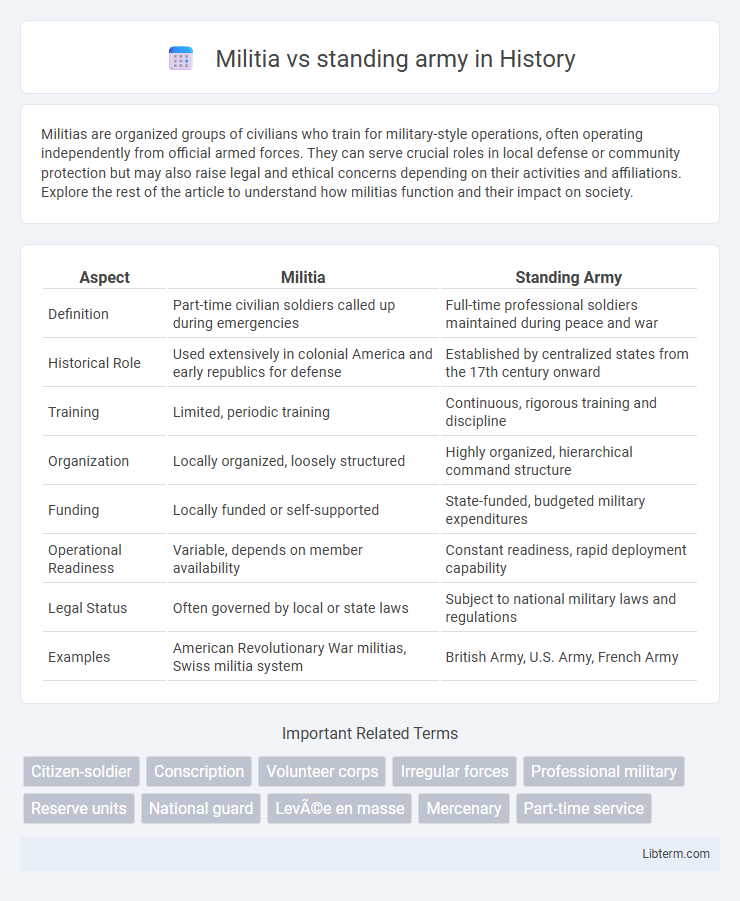Militias are organized groups of civilians who train for military-style operations, often operating independently from official armed forces. They can serve crucial roles in local defense or community protection but may also raise legal and ethical concerns depending on their activities and affiliations. Explore the rest of the article to understand how militias function and their impact on society.
Table of Comparison
| Aspect | Militia | Standing Army |
|---|---|---|
| Definition | Part-time civilian soldiers called up during emergencies | Full-time professional soldiers maintained during peace and war |
| Historical Role | Used extensively in colonial America and early republics for defense | Established by centralized states from the 17th century onward |
| Training | Limited, periodic training | Continuous, rigorous training and discipline |
| Organization | Locally organized, loosely structured | Highly organized, hierarchical command structure |
| Funding | Locally funded or self-supported | State-funded, budgeted military expenditures |
| Operational Readiness | Variable, depends on member availability | Constant readiness, rapid deployment capability |
| Legal Status | Often governed by local or state laws | Subject to national military laws and regulations |
| Examples | American Revolutionary War militias, Swiss militia system | British Army, U.S. Army, French Army |
Introduction to Militia and Standing Army
Militia consists of civilian volunteers who undergo intermittent military training to defend their community, contrasting with a standing army composed of full-time, professional soldiers maintained by a government. Militias often serve as a supplementary defense force during emergencies or conflicts, relying on local knowledge and rapid mobilization. Standing armies provide continuous readiness and advanced training, enabling sustained military operations and national defense.
Historical Origins of Militias and Standing Armies
Militias originated as local defense forces composed of civilian volunteers, prevalent in medieval Europe and colonial America, where organized standing armies were rare or politically sensitive. Standing armies emerged in the early modern period, reflecting centralized state power with permanent, professional soldiers maintained year-round, as seen in the formation of the British and French armies in the 17th century. The historical contrast highlights militias as decentralized, temporary forces rooted in community defense, while standing armies represent the institutionalization of military power by the state.
Defining the Militia: Structure and Function
The militia consists of civilian volunteers organized to provide local defense, distinct from a professional standing army maintained by the state. Its structure typically involves part-time members who engage in military training while retaining civilian occupations, enabling rapid mobilization during emergencies. Functionally, militias serve as a supplementary force for internal security, border patrol, and support roles, emphasizing community-based defense rather than extended offensive operations.
Understanding the Standing Army: Roles and Organization
A standing army is a permanent, professional military force maintained by a government for defense and national security. Its roles include rapid response to threats, continuous training, and sustained military readiness, with an organized hierarchy, specialized units, and defined command structures. Unlike militias, standing armies operate under centralized control with consistent funding, formal recruitment, and standardized equipment.
Key Differences Between Militia and Standing Army
Militia consists of civilian volunteers trained to provide local defense, while a standing army is a permanent, professional military force maintained by the government. Militia members typically serve part-time and may be called upon only during emergencies, whereas standing armies operate continuously with full-time soldiers. The standing army has structured hierarchy, specialized training, and advanced weaponry, distinguishing it from militias, which often have limited resources and decentralized command.
Advantages and Disadvantages of Militias
Militias offer the advantage of rapid local mobilization and cost efficiency since members are typically volunteers with civilian occupations, reducing the financial burden compared to maintaining a full-time standing army. However, militias often face disadvantages such as variable training standards, inconsistent discipline, and limited access to advanced weaponry, which can compromise their effectiveness in large-scale or prolonged conflicts. Their decentralized structure may also lead to coordination challenges and difficulties in maintaining coherent command and control during operations.
Strengths and Limitations of Standing Armies
Standing armies possess continuous training and professional discipline, ensuring rapid deployment and sustained military readiness during conflicts. Their limitations include high maintenance costs and potential for bureaucratic inertia, which can reduce adaptability in unconventional warfare. The centralized command structure promotes strategic coordination but may limit flexibility compared to more decentralized militia units.
Militia and Standing Army in Modern Warfare
Militias in modern warfare serve as flexible, volunteer forces often composed of local civilians with limited formal training and equipment, allowing rapid mobilization for territorial defense or insurgency operations. Standing armies consist of professional, full-time soldiers with comprehensive training, advanced technology, and sustained logistical support, enabling prolonged and complex military engagements across multiple theaters. The strategic use of militias complements standing armies by providing local intelligence, asymmetrical tactics, and adaptive responses in hybrid warfare environments.
Legal and Constitutional Perspectives
The distinction between militia and standing army is rooted in constitutional frameworks, with militias often constitutionally defined as part-time civilian forces intended for local defense, exemplified by the Second Amendment of the U.S. Constitution which preserves the right to keep and bear arms in relation to a "well regulated Militia." Standing armies, established and maintained by federal or state governments, require legislative approval and are subject to strict legal oversight to prevent misuse of military power against civilians. Legal debates frequently center on the balance of power, civil liberties, and the role of militias as a check against potential government overreach in maintaining standing armies.
Conclusion: Comparing Militia and Standing Army in Today’s World
Militias offer flexibility and local knowledge while standing armies provide professional training and advanced equipment crucial for national defense. Modern security challenges demand rapid response and sustained operations, often favoring standing armies' structured command and logistical support. However, integrating militia forces can enhance community resilience and supplement military capabilities in asymmetric warfare.
Militia Infographic

 libterm.com
libterm.com